Due to rapid urbanization rates worldwide, the bee population is decreasing significantly.
Extensive human encroachment has left these creatures without a habitat, exposing their lives to multiple risks and hampering their productivity, especially in making honey.
However, if you are a bee farmer, you can work around this situation by constructing a bee hotel. A bee hotel is designed to provide a home to solitary bees that live naturally in cracks, hollows, and holes instead of hives. The good thing about these structures is that they are cheap and you can also make one yourself.
Why Are Bee Hotels Important?
Here are the top benefits of constructing a bee hotel.
They Provide a Habitat for Bees
Many people associate bees with hives, but not all of them live in these structures.
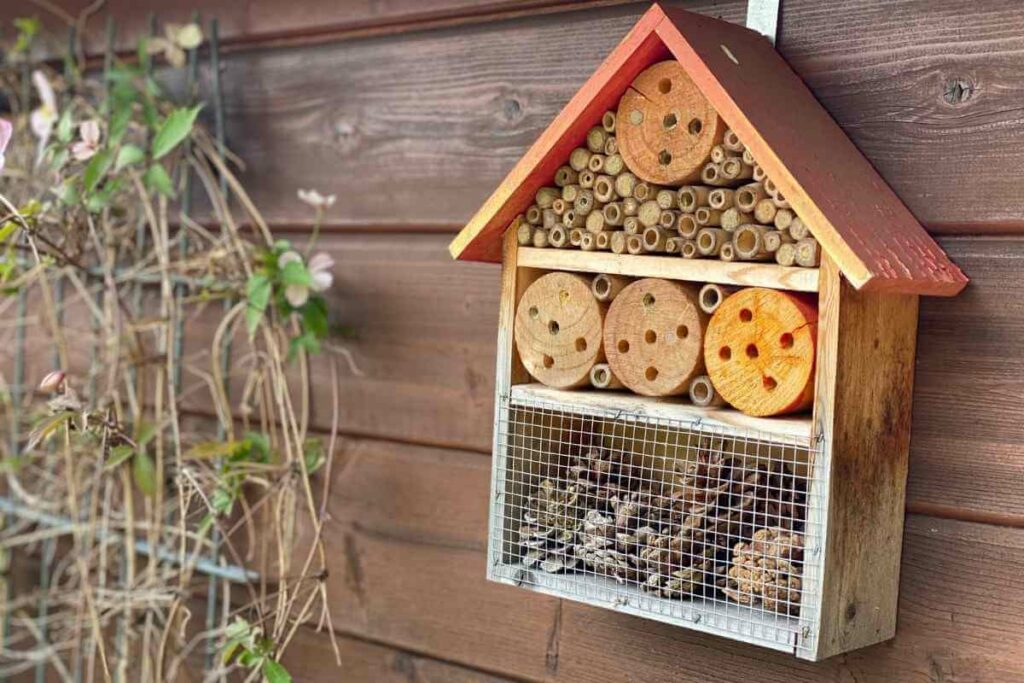
Honey bees are the kind that constructs hives, and they make up a paltry 15% of the bee population.
The remaining 85%, known as solitary bees, mostly wander around and reside on burrows, cracks, hollows, and holes.
Nice Thing to Do: By constructing a bee hotel, you provide a habitat to these bees. This allows them to breed and ensure that they don’t go extinct.
They Don’t Take Up Large Spaces
You don’t need a large space to put up a bee hotel.
The most crucial components are holes and other materials for the bees to live in.
Additionally, you can include some pot plants and flowers to attract the bees to your garden.
Such include thyme, chives, rosemary, parsley, mint, and geraniums, etc.
They Are Easy to Construct
Do you know that you can build a bee hotel by joining drinking straws or bamboo tubes together?
Recycled wooden logs can also make excellent material for building these structures.
Bees Are Useful
When bees are actively moving around your garden, they’ll pollinate your herbs, flowers, and vegetables.
The more bees you have, the more your crops will thrive. Thus, it’s a win-win situation for you and the bees.
Solitary Bees Are Friendly
Unlike honey bees, solitary bees are friendly to humans and rarely sting.
When they sting, the pain is milder than stings by other species.
Even Better: They travel alone, hence the name solitary. This means that they’ll never attack you like a swarm.
Bee Hotels Are Educational Tools
It’s fascinating to watch bees as they bring nectar, pollen grains, and other materials to a bee hotel.
You can use this to teach your children about nature’s diversity and the behavior of insects.
Specifically, they’ll know more about the life cycle of these insects.
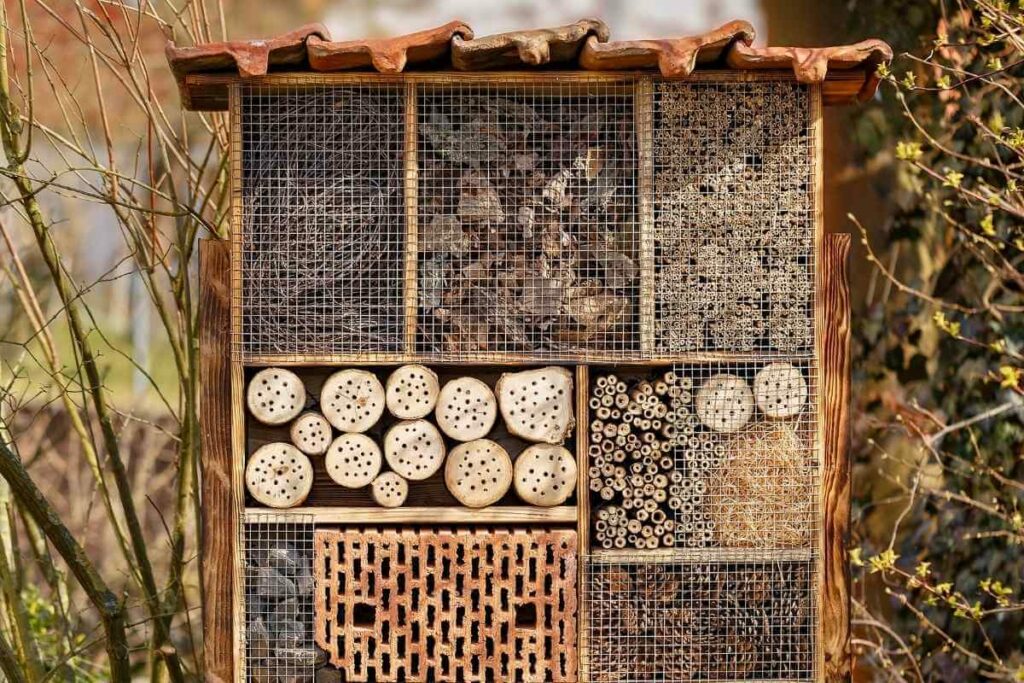
However, it’s worth noting that solitary female bees tend to sting, though not as aggressively as honey bees. You have to attack them for them to sting you.
That said, some people are allergic to stings by solitary bees.
Ensure that you wear protective gear when taking your kids for an educational tour in a bee hotel.
How To Make A Bee Hotel
Building a bee hotel is a fast and inexpensive process.
How to make a homemade bee hotel is a simple process.
What materials do you need to make a bee hotel? You can make one using an empty plastic bottle with the top half cut off and the bottle top left intact.
Then, add some nesting material and place it under a roofed spot facing the east to receive adequate sunlight.
Other materials you can use to construct a bee hotel include:
- Bamboo tubes – thin, long bamboo tubes provide an excellent platform for bees to nest and thrive. Ensure that the stems you cut are not longer than 15 cm and not shorter than 10 cm.
- Clay-packed blocks and pipes – for species that like nesting in the soil, such as blue-banded bees, clay-packed blocks and pipes provide the most natural-like habitat. Pack clay into concrete blocks or PVC pipes, and don’t exceed a depth of 15 cm.
- Drilled logs – cut 30 cm long blocks or logs of untreated wood. Then, drill 10 cm deep holes into the cut end and ensure that they are two centimeters apart.
- Fennel stems – strip foliage into small cuttings that don’t exceed 15 cm. You can also use branches from grapevines, hydrangeas, and lantana.
Additional Building Tips for Bee Hotels
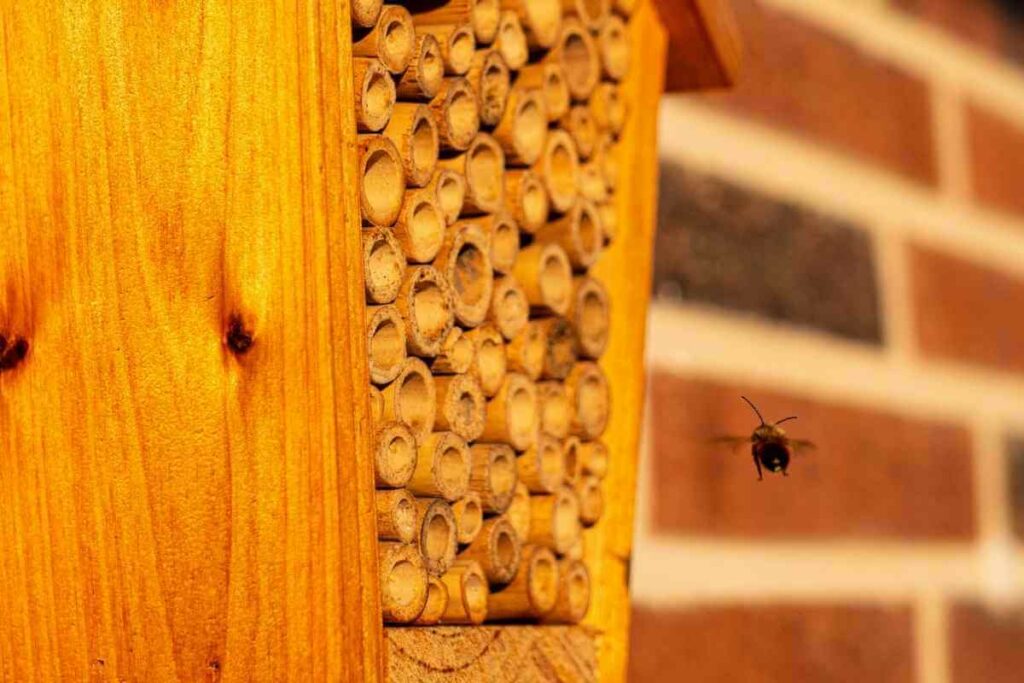
When constructing a bee hotel, keep the following in mind.
- Avoid composite materials that are susceptible to rain and excessive moisture. These include cardboard, chipboards, and particleboard.
- Check the unique preferences of the bees you want to rear. You don’t want to spend on a structure that your bees won’t find comfortable.
- Install a sloping and overhanging roof to prevent water from entering the bee hotel when it rains. A landing strip can also come in handy.
What Materials Make a Bad Bee Hotel?
If you don’t have the knowledge or the time to go the DIY way, here are the materials you need to avoid when purchasing a ready-made bee hotel.
- Large bamboo tubes with a diameter exceeding the recommended levels.
- Glass and plastic tubes, as they hold too much moisture.
- Lack of a protective roof or a roof without overhang.
- Shallow tubes whose depth is less than 15 cm. Some species lay female eggs at greater depths, meaning that shorter tubes increase the likelihood of not getting female bees.
- Splinters and rough edges since these can rip your bee’s wings.
- Lack of a backing board to protect the bees from moisture and wind.
Where Is the Best Place to Hang a Bee Hotel?
Not sure where to put your bee hotel?
The best place to put a bee hotel is a warm and sunny spot in your backyard garden.
The ideal height is one meter off the ground, but you can make it two if you’re tall enough.
Also, remember to install a roof to prevent moisture from dampening the nesting material.
Have You Noticed: If you want to know when your bees have left the hotel, check the openings. You’ll notice that they have some mud, an indicator that the female has laid eggs.
How Do You Maintain a Bee Hotel?
Notably, bees are most active during summer and spring.
The adults are less active in winter and autumn, making this the best time for routine maintenance on your bee hotel.
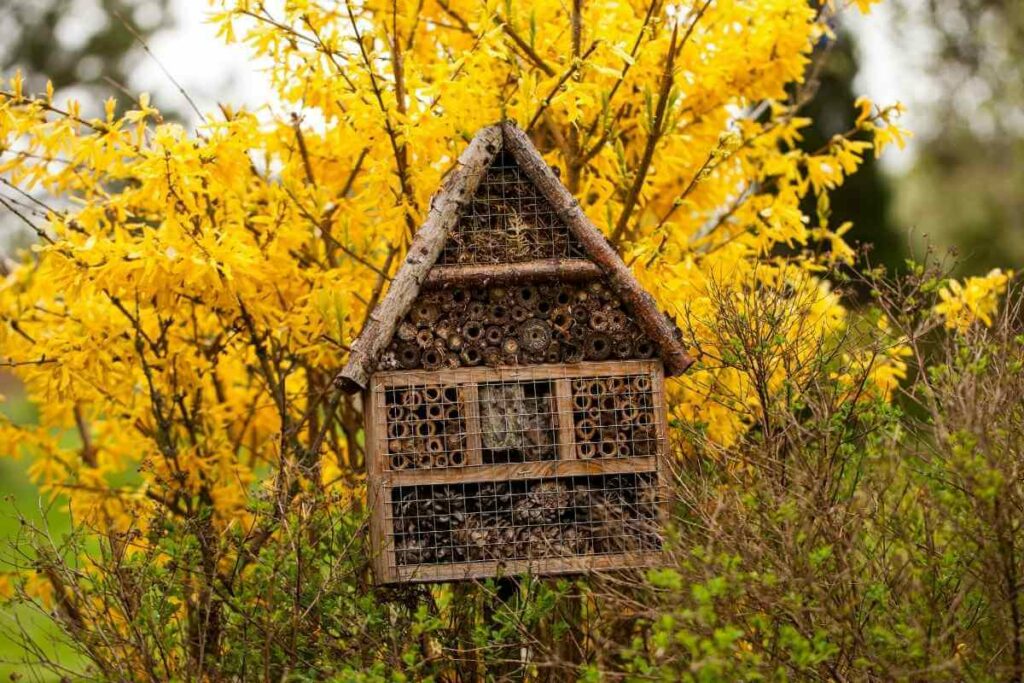
Keeping the hotel clean is an essential maintenance practice.
Ensure that you schedule a major cleaning exercise at least once yearly, and remember to clean all the pupae before you set them for release.
If you don’t tidy up, you increase the risk of:
- parasite infestations
- and even death to your bees
After the bees are out, remove the nesting material. Ensure that you replace the material and leave the place cool and dry, ready for the next breeding season.
Some bird species, such as woodpeckers, might attack your bee hotel looking to feed on your insects.
If you experience this challenge, install a wire mesh on the entrance.
Make sure that this coverage is more than an inch from the openings of the holes so that bees move freely.
Lastly, ensure you use high-quality reeds when constructing your bee hotel.
You need to confirm that:
- They are of the right size
- They don’t have splinters on the inside surface
- They have excellent moisture distribution
- At least one end is closed
If you opt for plant reeds, make clean cuts so that there are no cracks and splinters.
Reeds and rolled-up papers are better than drilled wood because they’re easily replaceable, lowering the risk of pathogenesis and disease infections.
Are Bee Hotels Effective?
Evidently, bee hotels are a good idea, but only when constructed using suitable materials and maintained properly.
The bees will flourish and have multiple positive benefits to your farm while you’ll be actively contributing to environmental conservation.
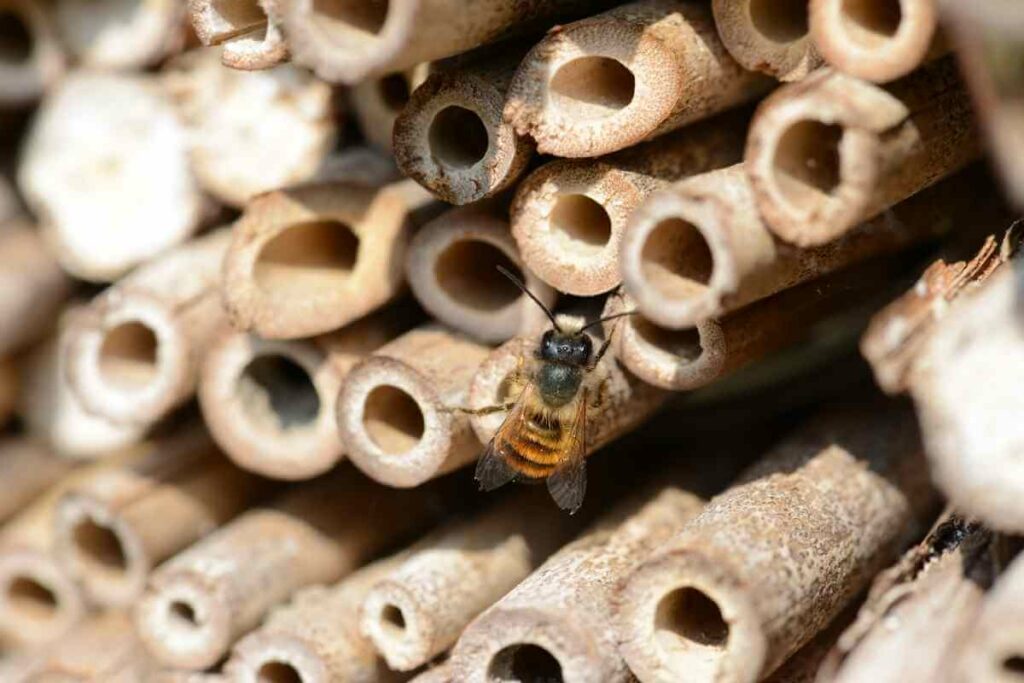
The problem, however, is that providing a home for too many bees might be counterproductive:
- Having too many of these species in one confined location increases the risk of diseases spreading.
- Another shortcoming of bee hotels, particularly the larger ones, is that most dead plant material and other waste are cleared during spring.
When that happens, cavity-breeding bees usually lack a nesting ground.
This is why you should always keep a check on the size of your project.
How Do I Attract Bees to My Bee Hotel?
Building a bee hotel might be simple, but the challenge is attracting bees to your bee hotel and keeping them.
Here are some of the strategies you can use to keep these insects close to your farm.
- Stop using pesticides – if you must, use organic options, as chemicals chase away bees.
- Ensure that your garden has flowers throughout the year. Have a slight bias on blue, white flowers, and yellow flowers, as bees prefer these over orange and red options.
- Put some dead plants around your farm to provide a nesting ground for bees.
Wrapping Up
Whether you’re passionate about beekeeping or general environmental conservation, constructing a bee hotel is a wise investment.
These structures are easy to build, and you don’t need to hire a professional to handle the task.
Lastly, ensure that you maintain hygiene when you construct the bee hotel.
If you don’t, your investment will go to waste, even if you purchase the best ready-made options in the market.
